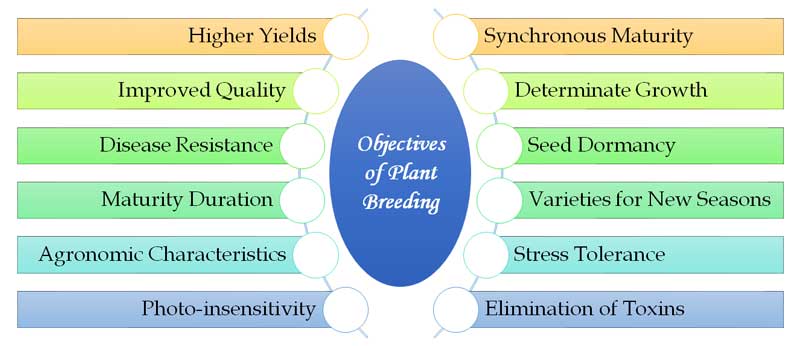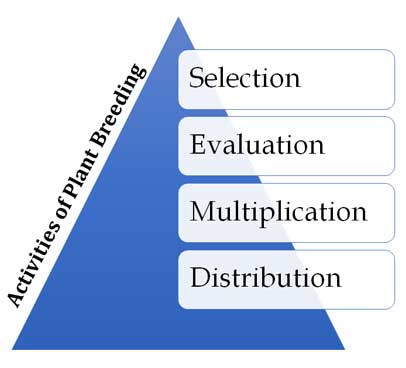Plant breeding is the process of intentionally manipulating plant genetics to create new and improved plant varieties with desired traits. This involves selecting and crossing plants with desirable characteristics, such as higher yields, resistance to pests and diseases, improved nutritional content, or adaptation to specific environmental conditions. The present post discusses the Objectives of Plant Breeding along with major research activities in plant breeding.
This post has the following learning objectives: (1). What is Plant Breeding? (2). Importance of Plant Breeding, (3). History of plant Breeding, (4). Objectives of Plant Breeding and (5). Activities in Plant Breeding
What is Plant Breeding?
Plant breeding deals with all the aspects of Increased Crop Production. It consists of principles and methods required for favorably changing the genetic constitution of crop plants for better performance (such as yield, disease resistance adaptability etc.). Plant breeding produces crop varieties more suited to human needs.
Importance of Plant Breeding
The area of land under cultivation is decreasing day by day. At the same time, the need for food production is growing due to the increase in population. All countries need to increase grain production to attain food security. However, there will be limitations for increasing the cropping area. Thus, the better option to increase food production is to increase production at a rate faster than the population rate. An increase in food production can be achieved by better management of crops through fertilizers, irrigation methods and most importantly by the use of Improved Crop Varieties. Development of improved crop varieties can be achieved through Plant Breeding.
History of Plant Breeding
Ø The plant breeding process started when man first chose plants for cultivation.
Ø Domestication is the process of bringing wild species under human management.
Ø Domestication is a method of plant breeding because there will be SELECTION during domestication by man knowingly or unknowingly.
Ø The selection gives better genotypes among wild types.
Ø Domestication of Gene: It is the transfer of specific genes from wild plants to cultivated plants by hybridization.
Ø The movement of man from one place to another resulted in the movement of cultivated plants also, which leads to Plant Introduction.
For details, see Plant Introduction in Plant Breeding
Ø Babylonians and Assyrians artificially pollinated date palms as early as 700 BC and this can be considered an early plant hybridization technique.
Ø Thomas Fairchild in 1717 produced the first artificial hybrid called Fairchild’s mule (a hybrid of Carnation and Dianthus).
Ø Plant Breeding is an Interdisciplinary subject since it took tools from other disciplines such as botany, genetics, cytogenetics, agronomy, plant physiology, plant pathology, entomology, microbiology, plant biochemistry, meteorology and statistics.
Objectives of Plant Breeding
Ø Plant Breeding activities start with one or more of the following objectives:
(a). Higher yields
(b). Improved quality
(c). Disease resistance
(d). Maturity duration
(e). Agronomic characteristics
(f). Photo-insensitivity
(g). Synchronous maturity
(h). Non-shattering characteristics
(i). Determinate growth
(j). Dormancy
(k). Varieties for new seasons
(l). Moisture stress & salt tolerance
(m). Elimination of toxic substances
(a). Higher Yields
Ø Getting a higher yield per unit area is the most important objective of any plant breeding programme.
Ø Higher yield in crop varieties is achieved by developing more sufficient genotypes by different plant breeding methods such as selection, hybridization, mutation breeding etc.
Ø Example: Hybrid varieties of Wheat-Sonalika, Rice- IR-8 and Maize- Ganga-11
(b). Improved quality
Ø Breeding for improved quality aims to improve the suitability of the crop for human use.
Ø The quality of characters varies from one crop to another.
Ø Examples of different qualities of crop plants are size, colour, cooking quality of grains, colour and flavour for fruits, keeping quality of vegetables, protein content in pulses etc.)
(c). Disease and insect Resistance
Ø Plant breeding offers the cheapest and most convenient method of disease and insect management in crop plants.
Ø Sometimes, it is the only feasible means of control of certain plant diseases. Example: Red Rust of wheat in India by Puccinia graminis tritici.
Ø Wild plants can be the source of disease resistance.
(d). Changes in maturity durations
Ø Changing the maturity duration of crops allows crop-rotation and extends the crop area.
Ø It also helps to avoid the unfavorable weather conditions in an area.
Ø Example: Wheat varieties suitable for late planting permitted rice-wheat rotation.
| You may also like NOTES in... | ||
|---|---|---|
| BOTANY | BIOCHEMISTRY | MOL. BIOLOGY |
| ZOOLOGY | MICROBIOLOGY | BIOSTATISTICS |
| ECOLOGY | IMMUNOLOGY | BIOTECHNOLOGY |
| GENETICS | EMBRYOLOGY | PHYSIOLOGY |
| EVOLUTION | BIOPHYSICS | BIOINFORMATICS |
(e). Agronomic characteristics
Ø This objective aims to change agronomic features such as height, tillering, branching, erect or trailing habit etc. of plants.
Ø Example: Dwarfness in cereals is associated with lodging resistance and fertilizer responsiveness.
(f). Photo-insensitivity
Ø Making the plants photo-insensitive to daylight duration permits the cultivation of a crop in new areas.
Ø Example: Photo-insensitive wheat and rice permitted their cultivation in new areas. Rice is now cultivated in Punjab.
(g). Synchronous maturity
Ø Synchronous maturity is the maturity of a crop species at a time.
Ø Synchronous maturity enables uniform maturity of crops and hence reduces the harvesting cost.
Ø Synchronous maturity is highly desirable for Mung bean (Vigna radiata), where several pickings are necessary.
(h). Non-shattering characteristics
Ø Shattering is the opening of fruit soon as they mature. This is a problem in some seed crops such as legumes.
Ø If shattering of the fruits is delayed, the crops can be harvested easily with minimal loss.
Ø Example: Shattering is a major problem with Mung bean.
(i). Determinative growth
Ø In determinative growth, the growth stops once a genetically pre-determined structure such as flower formation.
Ø Determinative growth allows plants to utilize energy for the betterment of reproductive parts such as fruits and seeds, rather than wasting the energy in vegetative growth.
Ø Example: Determinative growth is highly desirable in crops like pigeon peas and cotton where vegetative growth of the plant is very high.
(j). Dormancy of seeds
Ø The dormancy of seeds inhibits seed germination before harvesting.
Ø Example: Barley seeds germinate immediately if there are rains at the time of maturity. This will spoil the harvest.
Ø In some cases, it may desirable to remove dormancy with plant breeding methods to initiate seed germination.
(k). Varieties for new seasons
Ø Plant breeding allows the development of varieties suitable for the off-season.
Ø Example: Maize is a kharif crop, Plant breeding enabled to grow maize as rabi.
Ø Kharif: autumn crop sown at the beginning of the summer rains
Ø Rabi: grain crop sown in September and reaped in the spring
(l). Moisture and drought stress resistance and Salt tolerance
Ø Developing crop varieties having moisture stress and salt tolerance allow cultivation in rain red areas and saline soils respectively.
Ø Example: development of drought-stress resistant varieties of rice allows dry land cultivation.
(m). Elimination of toxic substances
Ø Removal of toxic substances from crops makes them safe for consumption.
Ø Example: Lathyrus sativus seeds have a neurotoxin, β-N-oxalylamine alanine (BOAA) which causes paralysis.
Ø Removal of toxic substances increases the nutritional value of crops.
Activities in Plant Breeding
Ø Desired changes in genotypes of crop plants and subsequent benefits to farmers are done by a series of interrelated and interdependent activities, collectively denoted as ‘Activities in Plant Breeding.
Ø These activities in plant breeding include:
$. Creation of variation: First and foremost
$. Domestication
$. Germplasm collection
$. Plant introduction
$. Hybridization
$. Induced mutation
$. Polyploidy induction
$. Somaclonal variations
$. Genetic engineering
Activities in Plant Breeding
(1). Selection
Ø Selection is the identification and isolation of a desirable combination of characters and growing their progenies.
Ø Selection is done based on phenotype (yields)
(2). Evaluation
Ø Selected individuals are tested for the traits (yields) and compared with existing best varieties (checks).
Ø Superior varieties than the ‘checks’ are selected for certification.
(3). Multiplication
Ø Multiplication is the large-scale production of seeds by certified seed-producing agencies.
(4). Distribution:
Ø Certified seeds are ultimately distributed to farmers.
Ø The whole activity may take many years.
<<< Back to PLANT BREEDING Notes
| You may also like... | ||
|---|---|---|
| NOTES | QUESTION BANK | COMPETITIVE EXAMS. |
| PPTs | UNIVERSITY EXAMS | DIFFERENCE BETWEEN.. |
| MCQs | PLUS ONE BIOLOGY | NEWS & JOBS |
| MOCK TESTS | PLUS TWO BIOLOGY | PRACTICAL |
You might also like…
@. Achievements of Plant Breeding



